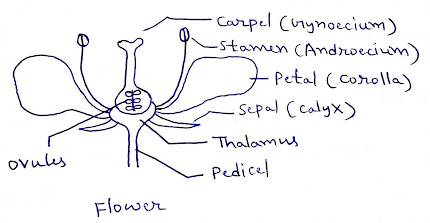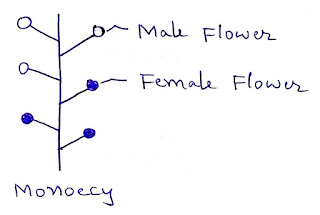Modes of Pollination in Crop Plants
परागण (Pollination):- परागकणों का पुंकेसर के परागकोषों से निकलकर अंडप के वर्तिकाग्र तक पहुँचने की प्रक्रिया को परागण कहते हैं। परागण 2 प्रकार का होता है:-
(Pollination is the process of the transfer of pollen from the anther of the stamens on to the surface of the stigma. Pollination is of 2 types: -)
1. स्वपरागण
2. परपरागण
1. स्वपरागण (Self Pollination):- जब एक पुष्प के परागकण उसी पौधे के पुष्प की वर्तिकाग्र पर स्थानांतरित होते हैं तो इसे स्वपरागण कहते हैं। 2 प्रकार-
(When the pollen of a flower is transferred on to the stigma of the flower of the same plant, it is called self-pollination. 2 types-)
a. स्वयुग्मन(Autogamy)
b. विषमयुग्मन (Geitonogamy)
a. स्वयुग्मन (Autogamy):- जब एक पुष्प के परागकण उसी पुष्प की वर्तिकाग्र पर स्थानांतरित होते हैं तो इसे स्वयुग्मन कहते हैं।
(When the pollen of a flower is transferred on to the stigma of the same flower, it is called autogamy.)
b. विषमयुग्मन (Geitonogamy):- जब एक पुष्प के परागकण उसी पौधे के दूसरे पुष्प की वर्तिकाग्र पर स्थानांतरित होते हैं तो इसे विषमयुग्मन कहते हैं।
(When the pollen of one flower is transferred on to the stigma of another flower of the same plant, it is called Geitonogamy.)
स्वपरागण के लिए पौधों में अनुकूलताएं:-
(Adaptations in plants for self-pollination: -)
I. द्विलिंगता (Bisexuality):- जब पौधों में द्विलिंगी पुष्प पाये जाते हैं तो इसे द्विलिंगता कहते हैं। द्विलिंगी पुष्पों में नर भाग पुंकेसर व मादा भाग अण्डप दोनों एक ही पुष्प में पाये जाते हैं। इस प्रकार परागकोष व वर्तिकाग्र दोनों पास पास स्थित होते हैं। परागकोष के स्फुटित होते ही परागकण पास स्थित वर्तिकाग्र पर आसानी से स्थानांतरित हो जाते हैं और स्वपरागण हो जाता है। इस प्रकार स्वपरागण के लिए पौधों में द्विलिंगी पुष्पों का होना आवश्यक है इसलिए स्वपरागित फसलों में हमेशा द्विलिंगी पुष्प ही पाये जाते हैं।
(When bisexual flowers are found in plants, it is called bisexuality. In bisexual flowers, both the male part stamens and the female part carpels are found in the same flower. Thus both anther and stigma are located close to each other. As soon as the anther is dehisced, the pollen gets transferred easily to the stigma near it and self-pollination occurs. Thus, it is necessary for plants to have bisexual flowers for self-pollinating, so bisexual flowers are always found in self-pollinated crops.)
II. समकालपक्वता (Homogamy):- जब द्विलिंगी पुष्प के परागकोष व वर्तिकाग्र दोनों एक ही समय परिपक्व होते हैं तो इसे समकालपक्वता कहते हैं। अर्थात जिस समय परिपक्व परागकोषों का स्फुटन होता है उस समय वर्तिकाग्र ग्राही अवस्था में होती है। इस प्रकार स्वपरागण के लिए पौधों में समकालपक्वता का होना आवश्यक है इसलिए स्वपरागित फसलों में समकालपक्वता पायी जाती है।
(When both the anther and the stigma of a bisexual flower mature at the same time, it is called homogamy. That is, the stigma is in the receptive state at the time when the mature anther is dehisced. Thus, it is necessary to have homogamy in plants for self-pollination, therefore, homogamy is found in self-pollinated crops.)
III. निमिलित परागण (Cleistogamy):- जब परागण व निषेचन एक बंद पुष्प कलिका में होता है तो इसे निमिलित परागण कहते हैं। यह स्वपरागण को सुनिश्चित करता है और परपरागण को रोकता है। कुछ फसलों में ही यह पाया जाता है जैसे - गेहूँ, जौं, जई व अन्य घास जातियाँ।
(When pollination and fertilization occurs in a closed flower bud, it is called Cleistogamy. This ensures self-pollination and prevents cross-pollination. It is found only in some crops such as wheat, barley, oats and other grass species.)
IV. उन्मील परागण (Chasmogamy):- जब पुष्प परागण की प्रक्रिया पूर्ण होने के पश्चात खुलता है तो इसे उन्मील परागण कहते हैं। यह स्वपरागण को सुनिश्चित करता है और परपरागण को रोकता है।कुछ फसलों में ही यह पाया जाता है जैसे - गेहूँ, जौं, जई व धान।
(When the flower opens after the completion of pollination process, it is called chasmogamy. It ensures self-pollination and prevents cross-pollination. It is found only in some crops such as wheat, barley, oats and paddy.)
V. परागकोषों की स्थिति (Position of Anthers):- कुछ जातियों में वर्तिकाग्र चारों ओर से परागकोषों से इस प्रकार घिरी रहती है कि यह स्वपरागण को सुनिश्चित करती है। यह स्थिति टमाटर व बैंगन में पायी जाती है। लेग्यूम फसलों में पुंकेसर व वर्तिकाग्र दलों में इस प्रकार से बंद रहते हैं कि ये स्वपरागण को सुनिश्चित करते है। जैसे मटर, चना, सोयाबीन आदि।
(In some species, the stigma is surrounded by anthers around it in such a way that it ensures self-pollination. This condition is found in tomato and brinjal. In legume crops, stamens and stigmas remain enclosed in such a way that they ensure self-pollination. Such as peas, chickpeas, soybeans etc.)
स्वपरागित फसलों के उदाहरण (Examples of Self Pollinated Crops):- गेहूँ, जौं, धान, जई, मटर, मूंगफली, चना, सोयाबीन, टमाटर, भिंडी, बैंगन, मिर्च, आलू आदि।
(Wheat, Barley, Paddy, Oats, Peas, Groundnut, Gram, Soybean, Tomato, Okra, Brinjal, Chilli, Potato etc.)
2. परपरागण (Cross Pollination):- जब एक पुष्प के परागकण दूसरे पौधे के पुष्प की वर्तिकाग्र पर स्थानांतरित होते हैं तो इसे परपरागण कहते है।
(When the pollen of one flower is transferred on to the stigma of flower of another plant, it is called cross pollination.)
परागण कारक (Pollinating Agents):- जो परागकणों को एक पौधे से दूसरे पौधे पर लेकर जाते है।
(Which carry pollens from one plant to another.)
i. कीट परागण (Entomophilly):- कीटों के द्वारा परागकणों को एक पुष्प से दूसरे पुष्प पर स्थानांतरित किया जाता है। मधुमक्खियों का योगदान सर्वाधिक रहता है।
(Pollens are transferred from one flower to another flower by insects. Honey bees contribute the most.)
ii. वायु परागण (Anemophilly):-
(Pollens are transferred from one flower to another flower by air. Examples - Poaceae family plants)
iii. जल परागण (Hydrophilly):- जल के द्वारा परागकणों को एक पुष्प से दूसरे पुष्प पर स्थानांतरित किया जाता है। उदाहरण - जलीय पौधे
(Pollens are transferred from one flower to another flower by water. Examples - aquatic plants)
iv. जन्तु परागण (Zoophilly):- जंतुओं के द्वारा परागकणों को एक पुष्प से दूसरे पुष्प पर स्थानांतरित किया जाता है।
(Pollens are transferred from one flower to another flower by animals.)
परपरागण के लिए पौधों में अनुकूलताएं:-
(Adaptations in plants for cross-pollination: -)
I. एकलिंगता (Dicliny, Unisexuality):- जब पौधों में एकलिंगी पुष्प पाये जाते हैं तो इसे एकलिंगता कहते हैं। एकलिंगी पुष्पों में केवल नर भाग पुंकेसर या मादा भाग अण्डप एक ही उपस्थित होता है। इस प्रकार परागकोष व वर्तिकाग्र दोनों दूर दूर स्थित होते हैं।
(When unisexual flowers are found in plants, it is called unisexuality. In unisexual flowers, only the male part stamens or the female part carpels are present. Thus both anther and stigma are located far away.)
नर व मादा पुष्पों की स्थिति के आधार पर यह दो प्रकार की होती है:-
(Depending on the position of male and female flowers, it is of two types: -)
i. द्विलिंगाश्रीयता (Monoecy)
ii. एकलिंगाश्रीयता (Dioecy)
i. द्विलिंगाश्रीयता (Monoecy):- जब नर व मादा पुष्प दोनों एक ही पौधे पर उपस्थित होते हैं तो इसे द्विलिंगाश्रीयता कहते हैं। उदाहरण - आम, अरंडी, केला, मक्का, कुकुरबिट्स, अंगूर, स्ट्रौबरी, रबर, कसावा आदि। आम, अरंडी, केला में नर व मादा पुष्प एक ही पुष्पक्रम में पाये जाते हैं। मक्का में नर व मादा पुष्प अलग अलग पुष्पक्रमों में पाये जाते हैं।
(When both male and female flowers are present on the same plant, it is called monoecy. Examples - Mango, castor, banana, corn, cucurbits, grapes, strawberry, rubber, cassava etc. In mango, castor and banana, male and female flowers are found in the same inflorescence. Male and female flowers are found in different inflorescences in maize.)
ii. एकलिंगाश्रीयता (Dioecy):- जब नर व मादा पुष्प अलग अलग पौधों पर उपस्थित होते हैं तो इसे एकलिंगाश्रीयता कहते हैं। उदाहरण - पपीता, खजूर, शहतूत, पालक, सन, शतावर आदि।
(When male and female flowers are present on different plants, it is called dioecy. Examples - papaya, date Palm, mulberry, spinach, sunn, shatavar etc.)
II. विषमकालपक्वता (Dichogamy):- जब द्विलिंगी पुष्प के परागकोष व वर्तिकाग्र दोनों अलग अलग समय पर परिपक्व होते हैं तो इसे विषमकालपक्वता कहते हैं। अर्थात जिस समय परिपक्व परागकोषों का स्फुटन होता है उस समय वर्तिकाग्र ग्राही अवस्था में नहीं होती है। यह परपरागण को प्रोत्साहित करती है। यह दो प्रकार की होती है:-
(When both the anther and the stigma of a bisexual flower mature at different times, it is called dichogamy. It means, the stigma is not in the receptive state when the mature pollen is dehisced. It encourages cross-pollination. It is of two types:-)
i. स्त्रीपूर्वता (Protogyny)
ii. पुंपूर्वता (Protandry)
i. स्त्रीपूर्वता (Protogyny):- जब वर्तिकाग्र परागकोषों से पहले परिपक्व हो जाती है तो इसे स्त्रीपूर्वता कहते हैं। उदाहरण - बाजरा
(When the stigma matures before the anther, it is called protogyny. Example - Bajra)
ii. पुंपूर्वता (Protandry):- जब परागकोष वर्तिकाग्र से पहले परिपक्व हो जाते हैं तो इसे पुंपूर्वता कहते हैं। उदाहरण - मक्का, चुकंदर व अनेक अन्य जातियाँ।
(When anthers mature before stigma, it is called protandry. Examples - Maize, sugar beet and many other species.)
III. विषमवर्तिकी (Heterostyly):- जब एक पुष्प में पुतन्तु व वर्तिका भिन्न भिन्न लंबाई के होते हैं तो इसे विषमवर्तिकी कहते हैं। यह परपरागण को प्रोत्साहित करती है। उदाहरण - अलसी
(When the filament and style in a flower are of different lengths, it is called heterostyly. It encourages cross-pollination. Example - Linseed)
IV. हर्कोगेमी (Herkogamy):- जब द्विलिंगी पुष्प में परागकोष व वर्तिकाग्र के मध्य कोई भौतिक बाधा उपस्थित होती है तो इसे हर्कोगेमी कहते हैं। इस भौतिक बाधा के कारण स्वपरागण में बाधा पड़ती है। इस प्रकार यह परपरागण को प्रोत्साहित करती है। उदाहरण - एल्फाएल्फा (लूसर्न)। इस पौधे में वर्तिकाग्र के ऊपर एक हायलिन झिल्ली पायी जाती है जो स्वपरागण को रोकती है। यह झिल्ली मधुमक्खियों के पुष्पों पर बैठने से टूटती है। इसके साथ ही मधुमक्खियों के शरीर पर लगे परागकणों द्वारा इन पुष्पों में परपरागण भी हो जाता है।
(When there is a physical barrier between the anther and the stigma in a bisexual flower, it is called herkogamy. Due to this physical barrier, self pollination is not possible. Thus, it encourages cross-pollination. Example - Alpha alpha (Lucerne). In this plant, a hyaline membrane is found above the stigma, which prevents self-pollination. This membrane breaks when the bees sit on the flowers. As a result, cross pollination takes place by the pollens which are attached on the body of the bees.)
V. स्वअनिषेच्यता (Self Incompatibility):- जब एक उर्वर परागकण उसी पुष्प को निषेचित करने में असमर्थ होता है तो इसे स्वअनिषेच्यता कहते हैं। यह स्वपरागण को रोकता है और परपरागण को प्रोत्साहित करता है। उदाहरण - सरसों, मूली, तंबाकू और अनेक घास जातियाँ।
(When a fertile pollen is unable to fertilize the same flower, it is called self incompatibility. It inhibits self-pollination and encourages cross-pollination. Examples - mustard, radish, tobacco and many grass species.)
VI. नर बंध्यता (Male Sterility):- जब एक पौधे के परागकण अजीवित व निष्क्रिय होते हैं अर्थात निषेचन करने में असमर्थ होते हैं तो इसे तो इसे नर बंध्यता कहते हैं। यह स्वपरागण को रोकता है और परपरागण को प्रोत्साहित करता है। संकर बीज उत्पादन के लिए यह एक महत्वपूर्ण साधन है।
(When the pollens of a plant are dead and inactive, it means unable to fertilize, it is called male sterility. It inhibits self-pollination and encourages cross-pollination. It is an important tool for hybrid seed production.)
परपरागित फसलों के उदाहरण (Examples of Cross Pollinated Crops):- मक्का, बाजरा, सूरजमुखी, अरंडी, लूसर्न, गन्ना, गाजर, गोभी, प्याज, मूली, शलजम, पालक, धनियाँ आदि।
(Maize, bajra, sunflower, castor, lucerne, sugarcane, carrot, cabbage, onion, radish, turnip, spinach, coriander etc.)
























